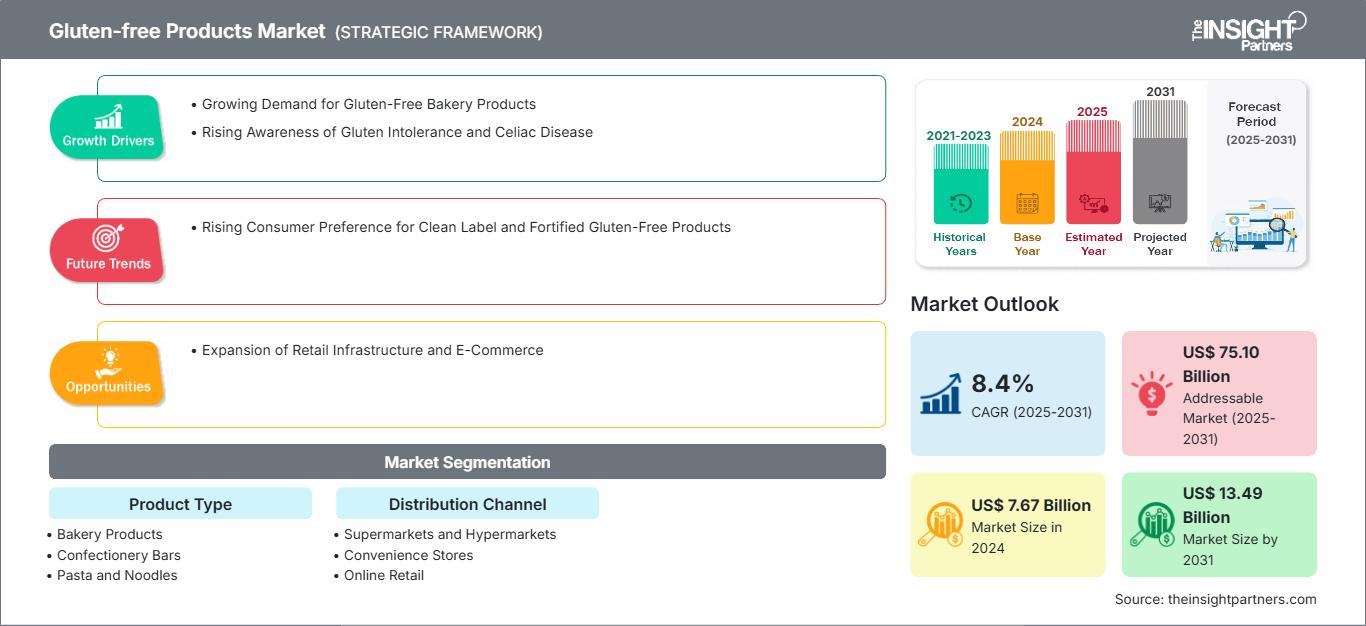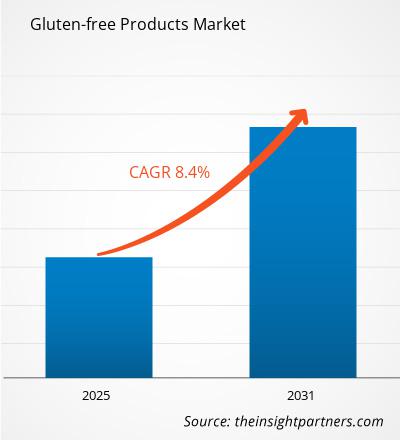글루텐프리 제품 시장 규모는 2024년 76억 7천만 달러에서 2031년에는 134억 9천만 달러에 이를 것으로 예상됩니다. 2025년부터 2031년까지 연평균 성장률 8.4%를 기록할 것으로 예상됩니다. 클린 라벨 및 강화 글루텐프리 제품에 대한 소비자 선호도 증가는 예측 기간 동안 시장에 새로운 트렌드를 가져올 것으로 예상됩니다.
글루텐프리 제품 시장 분석
글루텐 불내증과 셀리악병에 대한 인식이 높아짐에 따라 글루텐프리 제품에 대한 수요가 급증하고 있으며, 시장 참여자들은 전략적 계획을 통해 전국적으로 사업 영역을 확대하고 있습니다. 또한, 전자상거래 플랫폼 도입 증가로 오프라인 매장에 대한 의존도가 줄어들고 있습니다. 따라서 향후 몇 년 동안 소매 인프라와 전자상거래의 확대는 글로벌 글루텐 프리 제품 시장에서 수익성 있는 기회를 제공할 것으로 예상됩니다.
글루텐 프리 제품 시장 개요
글로벌 글루텐 프리 제품 시장은 셀리악병이나 글루텐 불내증과 같은 글루텐 관련 질환에 대한 소비자 인식 제고와 더 건강한 라이프스타일을 향한 광범위한 변화에 힘입어 최근 몇 년간 상당한 성장을 경험했습니다. 이제 많은 소비자들이 글루텐 프리 식단을 의학적 필요성 없이도 소화 개선, 에너지 증가, 체중 관리와 연관 짓습니다. 그 결과, 글루텐 프리 제품은 틈새 시장에서 주류 제품으로 전환되었으며, 슈퍼마켓, 레스토랑, 온라인 플랫폼 등에서 구매가 확대되었습니다. 제품 개발 혁신을 통해 맛과 식감이 개선되어 글루텐 프리 대안이 더욱 매력적으로 다가왔습니다. 주요 제품 범주에는 베이커리 제품, 스낵, 파스타, 즉석식품 등이 있습니다. 북미와 유럽과 같은 선진국에서 특히 성장세가 두드러지고 있으며, 아시아 태평양과 라틴 아메리카의 신흥 시장에서도 수요가 증가하기 시작했습니다. 시장의 진화는 변화하는 식생활 선호도, 높아진 건강 의식, 그리고 식품 생산에서 투명성과 클린 라벨 성분에 대한 수요 증가를 반영합니다.
이 보고서의 일부, 국가 수준 분석, Excel 데이터 팩을 포함하여 모든 보고서에 대한 사용자 정의를 무료로 받을 수 있을 뿐만 아니라 스타트업 및 대학을 위한 훌륭한 제안 및 할인을 이용할 수 있습니다
글루텐 프리 제품 시장: 전략적 통찰력

- 이 보고서의 주요 주요 시장 동향을 확인하세요.이 무료 샘플에는 시장 동향부터 추정 및 예측에 이르기까지 데이터 분석이 포함됩니다.
글루텐 프리 제품 시장 성장 동력 및 기회
글루텐 불내증 및 셀리악병에 대한 인식 제고
전통적으로 글루텐 불내증, 셀리악병 및 기타 관련 질환은 진단되지 않았고 널리 알려지지 않았습니다. 그러나 지난 몇 년 동안 의학 지식 향상과 건강 캠페인을 통해 글루텐 관련 질환을 파악하는 데 도움이 되었습니다. 이로 인해 소비자 행동이 변화하여 더 많은 사람들이 정식 진단 없이 식단에서 글루텐을 제거하거나 줄이는 것을 선택하고 있습니다. Beyond Celiac에 따르면, 미국인 133명 중 1명, 즉 전체 인구의 약 1%가 셀리악병을 앓고 있습니다. 또한 2019년 국립의학도서관(National Library of Medicine)에 발표된 연구에 따르면 사우디아라비아에서는 셀리악병이 흔하며, 생검으로 확인된 셀리악병의 정상 인구 유병률은 10.6%, 혈청 유병률은 15.6%입니다.
소매 인프라 및 전자상거래 확대
사우디아라비아 정부의 비전 2030 계획은 국가 소매 인프라 현대화 및 확장의 핵심 동력이었습니다. 이 계획은 경제 다각화와 소매업을 포함한 민간 부문의 성장을 촉진하는 것을 목표로 합니다. 그 결과, 사우디아라비아는 대형마트, 슈퍼마켓, 쇼핑몰, 편의점과 같은 현대적인 소매 공간을 빠르게 발전시켜 글루텐 프리 식품의 접근성을 크게 향상시켰습니다. 까르푸, 룰루, 판다, 다뉴브와 같은 대형 유통 체인점들은 전 세계 도시로 사업을 확장했으며, 증가하는 수요를 충족하기 위해 글루텐 프리 제품을 점점 더 많이 공급하고 있습니다. 소셜 미디어와 디지털 시장의 영향력은 전자상거래의 확장을 촉진했습니다. 글루텐 프리 브랜드들이 이러한 플랫폼을 활용하여 잠재 고객에게 다가가 제품을 홍보하고 있기 때문입니다. 인터넷과 스마트폰 보급률 증가, 신기술에 대한 빠른 접근성, 구매력 향상, 그리고 온라인 쇼핑 플랫폼이 제공하는 편의성은 전자상거래를 촉진하는 주요 요인입니다. 여러 지역에서 전자상거래가 확대됨에 따라, 글루텐 프리 제품 제조업체들은 월마트, 테스코, 아마존, 룰루 하이퍼마켓, 까르푸 등 유명 전자상거래 플랫폼을 통해 제품을 판매하며 온라인 입지를 강화하고 있습니다.
글루텐 프리 제품 시장 보고서 세분화 분석
글루텐 프리 제품 시장 분석 도출에 기여한 주요 부문은 제품 유형과 유통 채널입니다.
- 제품 유형별로 시장은 제빵류(케이크와 머핀, 비스킷과 쿠키, 피자, 빵과 롤, 기타 제빵류), 제과 바, 파스타와 면류, 아침 시리얼, 스낵, RTE 및 RTC 식사, 밀가루 등으로 세분화됩니다. 제빵류 부문은 2024년에 시장 점유율이 가장 높았습니다.
- 유통 채널 측면에서 시장은 슈퍼마켓과 하이퍼마켓, 편의점, 온라인 소매점 등으로 분류됩니다. 슈퍼마켓과 하이퍼마켓 부문은 2024년 시장 점유율 1위를 차지했습니다.
지역별 글루텐 프리 제품 시장 점유율 분석
시장 보고서의 지리적 범위는 북미, 아시아 태평양, 유럽, 중동 및 아프리카, 중남미의 5개 지역으로 나뉩니다. 유럽 시장은 예측 기간 동안 상당한 성장을 보일 것으로 예상됩니다.
유럽의 글루텐 프리 제품 시장은 셀리악병의 높은 유병률과 글루텐 관련 질환에 대한 소비자 인식 증가에 힘입어 성장하고 있습니다. 유럽 셀리악 협회(AOECS)에 따르면 유럽 인구 100명 중 1명이 셀리악병을 앓고 있는 것으로 추산되며, 이는 700만 명이 넘는 환자에 해당합니다. 그러나 경미한 불편함부터 심각한 합병증까지 다양한 증상으로 인해 진단받는 환자는 약 25%에 불과합니다. 셀리악병에 효과적인 유일한 치료법은 엄격한 글루텐 프리 식단이며, 이는 이 지역 전역에서 인증된 글루텐 프리 식품에 대한 수요를 촉진해 왔습니다.
유럽 위원회는 글루텐 프리 제품의 안전성과 표시를 보장하기 위해 엄격한 규정을 제정했으며, 위원회 시행 규정(Commission Implementing Regulation)은 "글루텐 프리"(20ppm 미만) 및 "매우 낮은 글루텐"(100ppm 미만) 표시에 대한 기준을 설정합니다. 유럽식품안전청(EFSA) 또한 글루텐 프리 식품 관련 건강 표시를 평가하여 소비자 신뢰를 강화하는 데 중요한 역할을 합니다. 또한, AOECS는 업계 협력, 인증 투명성, 그리고 글루텐 프리 제품의 접근성을 개선하기 위해 2023년에 글루텐 프리 얼라이언스(Gluten-Free Alliance)를 출범시켰습니다. 이 이니셔티브는 광범위한 EU 식품 안전 프레임워크와 연계되어 표준화된 시험 및 표시 관행을 장려합니다. 주요 업계 참여자들의 글루텐 프리 성분 혁신 및 생산 능력 확대에 대한 막대한 투자 덕분에 시장은 상당한 발전을 이루었습니다. 여러 유럽 식품 제조업체들이 증가하는 수요에 대응하기 위해 새로운 글루텐 프리 베이커리, 파스타, 스낵 제품을 출시했습니다. 예를 들어, 2024년 4월, 영국의 대표적인 베이커리 브랜드인 워버튼스(Warburtons)는 '글루텐 프리 소프트 피타(Gluten Free Soft Pittas)'를 출시했습니다. 이 제품은 4팩에 3파운드(약 4,000원)의 권장 소비자가격으로 판매됩니다. 워버튼스는 '시나몬 건포도 과일 번(Cinnamon and Raisin Fruity Buns)'과 '슈퍼 소프트 시드 롤(Super Soft Seeded Rolls)'을 출시한 후 글루텐 프리 제품에 상당한 투자를 해왔습니다. 또한, 셀리악병 진단을 받은 환자 외에도 알레르겐 프리 식단에 대한 소비자 선호도가 높아짐에 따라, 소매업체들은 인증된 글루텐 프리 제품의 진열 공간을 확대했습니다. 전자상거래 플랫폼의 확장은 특히 글루텐 프리 제품의 소매 공급이 제한적인 지역에서 접근성을 더욱 향상시켰습니다.
글루텐 프리 제품글루텐 프리 제품 시장 지역별 통찰력
The Insight Partners의 분석가들은 예측 기간 동안 글루텐프리 제품 시장에 영향을 미치는 지역별 동향과 요인들을 면밀히 분석했습니다. 이 섹션에서는 북미, 유럽, 아시아 태평양, 중동 및 아프리카, 그리고 중남미 지역의 글루텐프리 제품 시장 부문 및 지역별 현황도 살펴봅니다.
글루텐 프리 제품 시장 보고서 범위
| 보고서 속성 | 세부 |
|---|---|
| 시장 규모 2024 | US$ 7.67 Billion |
| 시장규모별 2031 | US$ 13.49 Billion |
| 글로벌 CAGR (2025 - 2031) | 8.4% |
| 이전 데이터 | 2021-2023 |
| 예측 기간 | 2025-2031 |
| 다루는 세그먼트 |
By 제품 유형
|
| 포함된 지역 및 국가 | 북미
|
| 시장 선도 기업 및 주요 회사 프로필 |
|
글루텐 프리 제품 시장 참여자 밀도: 비즈니스 역학에 미치는 영향 이해
글루텐 프리 제품 시장은 소비자 선호도 변화, 기술 발전, 그리고 제품의 효능에 대한 인식 제고 등의 요인으로 최종 사용자 수요가 증가함에 따라 빠르게 성장하고 있습니다. 수요가 증가함에 따라 기업들은 제품 라인업을 확장하고, 소비자 니즈를 충족하기 위한 혁신을 추진하며, 새로운 트렌드를 적극 활용하고 있으며, 이는 시장 성장을 더욱 가속화하고 있습니다.

- 을 얻으세요 글루텐 프리 제품 시장 주요 주요 플레이어 개요
글루텐 프리 제품 시장 뉴스 및 최근 동향
글루텐 프리 제품 시장은 주요 기업 간행물, 협회 데이터, 데이터베이스 등 1차 및 2차 연구를 통해 수집된 정성적, 정량적 데이터를 통해 평가됩니다. 시장의 주요 동향은 다음과 같습니다.
- 건강에 좋은 파스타 제조업체 Goodles가 글루텐 프리 파스타 라인을 출시했습니다. 이 라인업은 루디루스, 럭키 펜네, 트위스트풀 씽킹 등의 형태로 제공됩니다. (출처: Goodles, 보도자료, 2024년 10월)
- 글루텐 프리 냉동 식품 및 간식 제조업체 Feel Good Foods가 글루텐 프리 냉동 닭고기 수프 만두를 출시했습니다. 쌀가루로 만든 만두피에 닭고기, 육수, 파, 생강을 섞어 채운 만두입니다. (출처: Feel Good Foods, 보도자료, 2024년 10월)
글루텐 프리 제품 시장 보고서 범위 및 제공 내용
"글루텐 프리 제품 시장 규모 및 예측(2021~2031)" 보고서는 아래 영역을 포괄하는 시장에 대한 자세한 분석을 제공합니다.
- 범위에 포함된 모든 주요 시장 부문에 대한 글로벌, 지역 및 국가 수준의 글루텐 프리 제품 시장 규모 및 예측
- 글루텐 프리 제품 시장 동향 및 추진 요인, 제약 및 주요 기회와 같은 시장 역학
- 자세한 포터의 5가지 힘 및 SWOT 분석
- 주요 시장 동향, 글로벌 및 지역 프레임워크, 주요 업체, 규정 및 최근 시장 개발을 포괄하는 글루텐 프리 제품 시장 분석
- 시장 집중도, 히트맵 분석, 주요 업체 및 글루텐 프리 제품의 최근 개발을 포괄하는 산업 환경 및 경쟁 분석 시장
- 자세한 회사 프로필
- 과거 분석(2년), 기준 연도, CAGR을 포함한 예측(7년)
- PEST 및 SWOT 분석
- 시장 규모 가치/거래량 - 글로벌, 지역, 국가
- 산업 및 경쟁 환경
- Excel 데이터세트
최근 보고서
관련 보고서
사용 후기
구매 이유
- 정보에 기반한 의사 결정
- 시장 역학 이해
- 경쟁 분석
- 고객 인사이트
- 시장 예측
- 위험 완화
- 전략 기획
- 투자 타당성 분석
- 신흥 시장 파악
- 마케팅 전략 강화
- 운영 효율성 향상
- 규제 동향에 발맞춰 대응




















 무료 샘플 받기 - 글루텐 프리 제품 시장
무료 샘플 받기 - 글루텐 프리 제품 시장